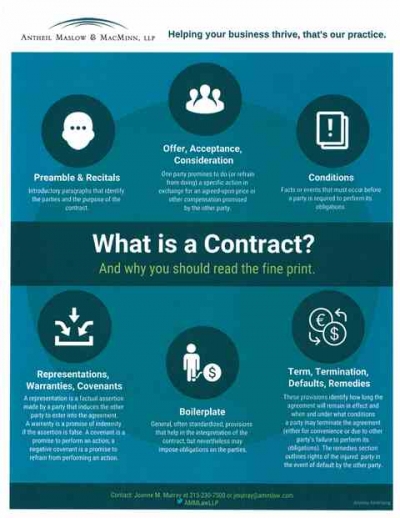AMM Blog
Welcome to the AMM Law Blog, a tool to help you keep up to date on current legal developments over the broad spectrum of our practice areas. We welcome your comments and suggestions to create a dynamic forum that will be of interest to readers and participants.
Use of Corporate Authority in Internal Business Disputes
Written by Thomas P. Donnelly Friday, September 07 2018 15:32In my many years of practice as a commercial litigator dealing with conflicts between shareholders, it has become clear time and again that one of the best things business owners can do when in business with multiple shareholders or partners is to have a well-defined agreement which governs the operations of the business. Not only can that agreement memorialize the respective rights and obligations of the parties, it can also provide dispute resolution mechanisms which may serve the parties well in the event of material disagreement. Utilizing the powers granted by the Business Corporations Law and granted by the terms of an agreement governing business owners can be complex and risky but can often force an acceptable resolution when the status quo is no longer tenable.
In the case of a corporation, a shareholders agreement or by-laws will often identify the corporate office which holds supreme executive authority subject only to removal of that corporate officer by a vote of the directors. If the officer controls sufficient votes from the board, removal by a disgruntled shareholder may be impossible. The acts of the executive are subject to the business judgment rule and granted a certain amount of deference at law.
A majority shareholder who holds the top executive office is free to wield that power, consistent with the business judgment rule, in many ways - including business dealings with outside parties and, generally, with respect to employment decisions. If the disgruntled shareholder is an employee of the company, which is often the case in small business, that shareholder’s continued employment may be at the discretion of the majority. Termination of employment, if justified, is a use of corporate power which often impacts on the relative negotiating positions.
Of course, a majority shareholder who exercises corporate authority can be faced with claims that the minority has been “frozen” or “squeezed” out of the business. In such cases, it is important that the majority have “clean hands” and has avoided self-dealing, corporate waste or fraud as such allegations, if proven, could result in the appointment of a custodian or receiver and a loss of control. Certainly the majority cannot transfer the assets of the business to a new entity controlled solely by the majority. However, the existing entity can be managed in a way that maximizes benefit to the majority consistent with the exercise of business judgment. The existence of a dispute between shareholders does not in and of itself negate the discretion afforded by the business judgment rule.
AMM counsels clients through the minefield of corporate authority and with regard to available strategies to address disputes which arise between business owners.
What is a Contract: Preamble/ Recitals - Let’s begin at the beginning
Written by Joanne Murray Friday, August 24 2018 13:58
This post continues my series aimed at explaining the main elements of a contract. These elements are outlined on the attached infographic. My goal is to define the key elements of a contract and to offer some tips and cautions to avoid costly mistakes as you approach these essential documents in your day-to-day business operations.
First up: the preamble and recital sections. The preamble of a contract is the introductory paragraph that identifies the parties to the agreement. It is typically followed by paragraphs known as recitals (also called the background section). Sometimes, these recital paragraphs are labeled “Whereas”. Taken together, the preamble and the recitals tell the who, what, when, and why of the transaction. In other words, they should tell the reader who the parties to the agreement are, the date of the agreement, and what the parties hope to accomplish by entering into the agreement.
As with stories told in other settings, inaccuracies and ambiguities in the preamble and recitals of a contract can cause problems down the road. One of the underlying purposes of a contract is to set forth the agreement of the parties so that their expectations can be enforced by a court or other tribunal. An accurate and detailed introduction to the contract can educate the person who is charged with resolving the dispute as to who the parties are, why they entered into the contract, and what their expectations were at the time the agreement was entered into.
One of the most common mistakes in these preliminary sections of a contract is to incorrectly name the owner of the business as a party, rather than using the entity name. This mistake results in the owner being personally obligated as a party to the contract, which is clearly not the result an owner expects after taking the trouble to incorporate.
While it may be tempting to gloss over these preliminaries without questioning their accuracy, I highly recommend taking the time to carefully review this section in every contract to be sure the story it tells is true and complete. It could prevent costly conflicts later.
Stay tuned for Part 2 of this series, which will move to the next element on the infographic: offer, acceptance, and consideration.
Aretha Franklin Died without an Estate Plan – Here is Why You Should Have One
Written by Elaine T. Yandrisevits Thursday, August 23 2018 21:27Shortly after Aretha Franklin died at the age of 76 after a battle with pancreatic cancer, documents filed in the Probate Court of Oakland County, Michigan by her family revealed that the legendary singer, who was estimated to be worth $80 million, did not execute a Last Will and Testament. Aretha Franklin now joins a growing list of celebrities, including Prince, Amy Winehouse, Kurt Cobain, Bob Marley, Jimi Hendrix, and Tupac Shakur, who all died without executing a Will or other estate planning documents. For many of these celebrities, their estates were, or are currently, subject to lengthy and protracted probate proceedings that played out for the media.
There are significant benefits to developing an estate plan, which can include a Will, Revocable Trust, and/or Irrevocable Trusts, even if you are not a celebrity.
First, and perhaps most importantly, developing an estate plan allows you to choose the beneficiaries of your estate, the amounts they receive, and how they receive those amounts. Individuals, like Aretha Franklin, who die without an estate plan will have their assets distributed according to their state’s intestacy laws or, for assets that contain beneficiary designations (such as IRAs, 401ks, and life insurance), according to the terms of the account provider. It is extremely difficult, if not impossible, for the personal representative of an estate to argue after an individual passes away that the intestacy rules should not apply when there is no Will or estate plan.
Second, creating an estate plan gives you flexibility to decide how your beneficiaries will receive assets. An estate plan could involve the creation of trusts, which allow the beneficiary to have the use of funds without having direct access to them. Trusts can be a useful tool for minor or young beneficiaries who may need time to develop prudent money management skills; for beneficiaries with special needs who cannot own significant assets outright without jeopardizing necessary public benefits; or for beneficiaries with significant wealth on their own or liability concerns who want to keep assets out of their own estates.
Third, an estate plan can, depending on the circumstances, allow you to reduce taxes that your estate may be subject to at your death. There are numerous estate planning techniques, many of which involve the use of trusts, that can be developed and implemented to reduce estate, inheritance, and/or generation-skipping taxes that may be assessed against an estate. These tax-planning options are extremely limited for intestate estates.
Fourth, the development of an estate plan may allow certain aspects of the estate administration to be completed in a more private manner than available for intestate estates. Probate records are public documents, so many of the details of an estate administration are available to the public. While a Will must be filed as part of a probate record, many trusts that could be created under an estate plan are not included in the probate record, and therefore do not become public. While public interest in the administration of your estate may be less than the interest in Aretha Franklin’s or Prince’s estates, the ability to shield some aspects of an estate from the public can be beneficial.
So, in the words of the late, great Queen of Soul...."You better think......"
PENNSYLVANIA’S PROPOSED RULEMAKING UNDER THE PENNSYLVANIA MINIMUM WAGE ACT
Written by Patricia Collins Thursday, August 23 2018 16:41PENNSYLVANIA’S PROPOSED RULEMAKING UNDER THE PENNSYLVANIA MINIMUM WAGE ACT
Reprinted with permission from the August 18th, 2018 issue of The Legal Intelligencer. (c) 2018 ALM Media Properties. Further duplication without permission is prohibited.
In 2016, the United States Department of Labor proposed changes to regulations regarding exemptions from the overtime and minimum wage requirements of the Fair Labor Standards Act (“FLSA”). The proposed changes nearly doubled the salary requirement to qualify for these exemptions. Employers hurried to change policies and reclassify employees in order to meet the December 31, 2016 deadline to comply with the new salary requirement. In late 2016, a federal court imposed an injunction on the imposition of those rules, and there the new regulations died (more at the hands of the Trump administration than as a result of legal challenges). Among other observations, the federal district court for the Eastern District of Texas concluded that the injunction was necessary because the new salary requirement was so high that it rendered the duties test “irrelevant.”
The proposed change was dramatic, and would have required significant policy and personnel changes. Now, Pennsylvania is taking on those salary requirements in a less dramatic, but no less significant way.
Joint Business Ownership: Unwinding Those Relationships Can Be Complicated and Costly
Written by Thomas P. Donnelly Friday, August 17 2018 19:35It is not unusual for business owners such as manufacturers and their suppliers and consultants to enter into joint ownership in the pursuit of mutual business goals. Those pursuing this strategy should consider that such entanglements can lead to costly future litigation should circumstances change and interests of the parties diverge. In a recent case, a dispute arose between owners of a custom manufacturing limited liability company in which AMM’s client (and a supplier to that same LLC) possessed 33 1/3% of the issued and outstanding ownership interests. The firm’s client also owned 100% of the stock in a separate business entity which supplied materials to the jointly owned custom manufacturer.
When the owners had a falling out, an issue arose with regard to the payment of outstanding invoices generated by the supplier for materials provided to the jointly owned custom manufacturer. When a resolution could not be reached, AMM, on behalf of the supplier, commenced litigation. During the litigation, the majority member of the jointly held custom manufacturer transferred all of the inventory and other assets to a newly formed entity, owned entirely by him, without the payment of consideration, that is to say, without compensating the supplier entity. The transfer of assets left the jointly held entity with insufficient assets to meet its’ liabilities; including the liabilities to the supplier. As a matter of strategy, the controlling member of the jointly owned entity allowed default judgment in favor of the supplier and against the jointly held custom manufacturer. The newly created entity went about doing business utilizing the inventory transferred without regard to the liability to the supplier.
The transfers gave rise to new and additional claims under the recently adopted Uniform Fraudulent Conveyances Act and claims of breach of fiduciary duty; all of which had to be litigated while the newly formed company operated a separate business. Clearly, a small business owner can no longer simply set up shop as a new entity when things go bad and debt accumulates. However, the complexity of ownership structure and relationship between the various entities made judicial intervention very difficult. In the end, the newly formed entity was forced to file a general assignment for the benefit of creditors; the majority owner lost his interest in all of the respective entities and eventually filed for personal bankruptcy.
The above is just one of many “war stories” encountered in attempting to unwind jointly owned business enterprises. Business owners and potential investors should think very carefully before engaging in shared ownership. What may seem like a mutually beneficial relationship at the outset can be costly and challenging to undo if things go bad in the future.
The take away for business owners and potential investors is to think very carefully before engaging in shared ownership. What may seem like a mutually beneficial relationship at the outset can be costly and challenging to undo if things go bad in the future.
5 Common Employment Issues That Can Scuttle the Sale of Your Business
Written by Patricia Collins Tuesday, August 14 2018 20:22The sale or merger of a business often uncovers employment problems that may scuttle the transaction, or impact the value of the business. In my employment law practice, I’ve seen a pattern of common employment issues businesses face when they are contemplating a transaction, or that emerge during due diligence. Below are the five most common of those issues:
1. Classification of employees as “exempt” or “nonexempt” under federal and applicable state law; and time clock and hourly pay policies, and compliance with federal and state overtime rules;
2. Classification of workers as independent contractors or employees;
3. Evaluation of benefit plans to ensure compliance with plan documents and federal benefits law, and evaluation of policies related to unregulated fringe benefits, such as vacation pay or sick pay;
4. Evaluation of whistleblower and harassment and discrimination complaint procedures;
5. Evaluation of employment contracts and restrictive covenants to ensure that the restrictions included therein will protect the seller and will inure to the benefit of the buyer.
A thorough review of employment policies and procedures and contracts will eliminate trouble in the process. AMM attorneys have experience guiding employers through these issues as part of our clients’ transactions. We can help employers address the crisis when it emerges as part of due diligence. More importantly, we can help employers improve their policies and contracts to maximize value and streamline transactions.

























